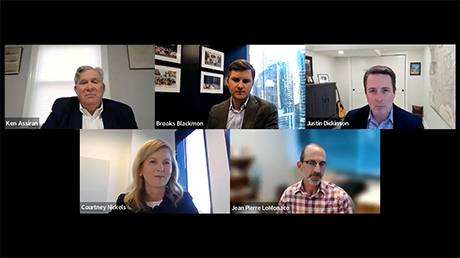The last few years have been a time of unpredictability in seniors housing, as the combined factors of pandemic recovery, rapidly rising interest rates, high inflation and labor shortages weighed heavily on investors and operators.
“There have been a lot of predictions and forecasts since 2020,” said JP LoMonaco, executive vice president at CBRE. “A lot have been spot on; a lot have been way off base. As we approach the end of 2023, it seems like forecasts about what the American economy will do in 2024 are more varied than ever.”
LoMonaco noted that investment banks, in particular, were caught off guard by the sudden change in the economy over the last 18 months. He added a very hopeful addendum, though: “One thing the banks agree on is the hardest part is over.”
LoMonaco made the comments during a webinar last week titled “What Will 2024 Hold for Seniors Housing Investment & Acquisition Activity?” The panel of industry experts included Justin Dickinson, founder and partner of Evolve Senior Living; Courtney Nickels, senior vice president at Artemis Real Estate Partners; Ken Assiran, managing principal at Capital Funding Group; and Brooks Blackmon, executive managing director at Blueprint Healthcare Real Estate Advisors.
CBRE sponsored the Seniors Housing Business event, which was the last of three webinars examining the industry’s investment outlook.
Blackmon agreed with LoMonaco’s assessment, noting that “there’s a tad more clarity into the future” now than there was six months ago.
“We feel a whole lot more confident underwriting new opportunities for sellers and knowing within a pretty reasonable range where pricing’s going to fall.”
Blackmon also noted that Blueprint’s transaction volume as a broker was nearly identical in 2022 and 2023 — approximately $2 billion in each year — but that that it was more transactions of a smaller size in 2023. The number of transactions increased about 25 percent in 2023, while the value of each transaction decreased about 25 percent.
Dickinson said that even more clarity is on the horizon. Rent increases have been very high in the last two years with little pushback from residents, who are aware of the financial challenges facing the industry. We’ll soon know if that rent growth is going to level off.
“We’re coming off 24 months of strong rate growth. Are we going to experience that similar rate growth in January? We will be able to answer that question very soon.”
A silver lining to the sharp rise in construction costs and the myriad operational challenges caused by the pandemic that have slowed development activity is that occupancy has had room to grow. With the growth of the seniors demographic, seniors housing development is primed to hit a new stride.
“Over the next few years, we’ll be moving into a strong growth cycle provided that the capital can be available to investors and developers,” said Assiran.
And while the panelists noted that most seniors housing properties have weaker profit margins than prior to the pandemic, that key metric is also coming back, according to Nickels.
“In our existing portfolio, we have seen some of our assets achieve and even exceed pre-COVID margins. It’s not for every property. Every market is different. One differentiator is stability of the onsite leadership team. That makes a difference in that speed and pace of recovery.”
To view a replay of the webinar, click here.
— Jeff Shaw

